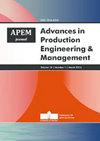The impact of using different lean manufacturing tools on waste reduction
IF 2.8
3区 工程技术
Q2 ENGINEERING, MANUFACTURING
引用次数: 55
Abstract
Lean and green production was introduced to the western manufacturing industry nearly thirty years ago. The essence of the new business model was to eliminate waste through lean tools according to Taiichi Ohno’s eight cate‐ gories of waste. Many companies became more competitive with waste reduc‐ tion techniques but some of them faced, and still are facing failures. Such failures are closely related with misapplication of lean and green tools, and its sequential order of implementation. In order to define most powerful lean tools for reduction of certain types of waste, a study was made among lean companies. The concept of a study was to define best lean toolbox for reduc‐ tion of each category of waste and to determine right sequential order of lean tools implementation. Stepwise multiple regression model revealed that Total Productive Maintenance, Poka‐Yoke, Kaizen, 5S, Kanban, Six Big Losses, Heijunka, Takt Time, Andon, OEE, SMED, and KPIs are best waste management techniques. Nevertheless, it has been demonstrated that 5S, Kaizen, Kanban, Poka‐Yoke and TPM are highly recommended for start of every lean manufac‐ turing initiative. © 2020 CPE, University of Maribor. All rights reserved.使用不同的精益生产工具对减少浪费的影响
精益和绿色生产是近三十年前引入西方制造业的。这种新商业模式的本质是根据大野耐一的八种废物分类,通过精益工具来消除浪费。许多公司在减少废物技术方面变得更具竞争力,但其中一些公司面临着失败,而且仍然面临着失败。这些失败与精益和绿色工具的误用及其实施的顺序密切相关。为了定义最强大的精益工具,以减少某些类型的浪费,研究精益公司。研究的概念是定义最佳的精益工具箱,以减少每种浪费,并确定精益工具实施的正确顺序。逐步回归模型显示,全面生产维护、Poka‐Yoke、Kaizen、5S、看板、Six Big Losses、Heijunka、Takt Time、Andon、OEE、SMED和kpi是最佳的废物管理技术。尽管如此,已经证明,5S、改善、看板、Poka - Yoke和TPM是每一个精益生产计划开始时强烈推荐的。©2020 CPE,马里博尔大学。版权所有。
本文章由计算机程序翻译,如有差异,请以英文原文为准。
求助全文
约1分钟内获得全文
求助全文
来源期刊

Advances in Production Engineering & Management
ENGINEERING, MANUFACTURINGMATERIALS SCIENC-MATERIALS SCIENCE, MULTIDISCIPLINARY
CiteScore
5.90
自引率
22.20%
发文量
19
期刊介绍:
Advances in Production Engineering & Management (APEM journal) is an interdisciplinary international academic journal published quarterly. The main goal of the APEM journal is to present original, high quality, theoretical and application-oriented research developments in all areas of production engineering and production management to a broad audience of academics and practitioners. In order to bridge the gap between theory and practice, applications based on advanced theory and case studies are particularly welcome. For theoretical papers, their originality and research contributions are the main factors in the evaluation process. General approaches, formalisms, algorithms or techniques should be illustrated with significant applications that demonstrate their applicability to real-world problems. Please note the APEM journal is not intended especially for studying problems in the finance, economics, business, and bank sectors even though the methodology in the paper is quality/project management oriented. Therefore, the papers should include a substantial level of engineering issues in the field of manufacturing engineering.
 求助内容:
求助内容: 应助结果提醒方式:
应助结果提醒方式:


